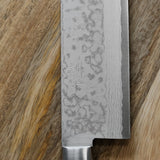Masutani VG10 Damascus Nakiri Knife Sairyu Blue
Type: Nakiri Knife (Double bevel edged)
Blade Material: VG10 Damascus Clad Stainless Steel
Core: VG10 (Cobalt Alloy Stainless Steel)
Blade Length: approx 165 mm
Blade Width: approx 45 mm
Thickness of Spine: approx max 1.8 mm
Overall Length: approx 292 mm
Weight: approx 156g (5.5 oz)
HRC: around 61
Handle: Reinforced Laminated Wood
The knives made in Echizen city are called "Echizen Uchi(Forging) Hamono(Cutlery)". The art of making Japanese kitchen knives has a history of about 700 years. Echizen Uchi Hamono is designated as "Traditional Crafts" by the Minister for Economy, Trade and Industry. These knives are forged by blacksmiths, these knives are harder to be chipped and the sharpness continues longer. The organization of material changes homogeneously, it is observed by a microscope.
The elegant wave pattern, commonly known as "Sumi Nagashi," is one of the treasures produced by Japan's cutlery tradition. Inspired by the craftsmanship of Japanese swords (Katana), the blade is constructed from a combination of high- and low-carbon stainless steel.
This knife is expertly forged to be durable enough for both home and professional use.
Made from VG-10, a high-carbon stainless steel containing cobalt, this steel is known for its excellent sharpness and wear resistance. It is favored by professionals and is produced by Takefu Special Steel Co., Ltd., a renowned Japanese company. if the entire blade is very hard, it is difficult to sharpen. The other case, if the blade is soft, it is dull, and the sharpness falls immediately. That is why this hard material is used in the centrr for superior edge retention, while softer steel is used along the side to allow for easier sharpening. Because its hardness, ceramic sharpening stones are recommended for maintaining the blade’s edge.
Take a look at our Ceramic Sharpening Stone.
NOTE:
The core steel is VG10, and the side steel is rust-resistant; however, please be sure to wash, wipe, and dry the knife thoroughly after each use. If rust appears on the blade, use a cleanser or take it to a sharpening service (note that scratches may occur).
Avoid twisting the edge or striking the blade. Do not cut frozen foods or bones, as the thinner, sharper edge of Japanese knives may chip or break. Since Japanese knives are handcrafted, slight scratches may appear naturally.




















